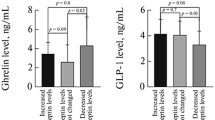Abstract
Parameters of insulin resistance and lipid transport were studied in nonobese subjects and in obese subjects with different body fat distribution, and the results were compared with current concepts of the physiological and biochemical mechanisms of abdominal (android) and gluteofemoral (gynoid) types of obesity, concomitant dyslipoproteinemias, and the roles of insulin and insulin resistance in these conditions. Disturbances of the hormonal regulation of lipid metabolism, which manifest themselves as hyperinsulinemia, insulin resistance, and a decreased serum level of the insulin antagonist somatotropin, were associated only with abdominal obesity and were considered to be one of the main causes of atherogenic dyslipoproteinemia in this type of obesity.
Similar content being viewed by others
REFERENCES
Sokolov, E.I., Sacharnyi diabet i ateroskleroz(Diabetes Mellitus and Atherosclerosis), Moscow: Nauka, 1996.
Perova, N.B., Mamedov, M.N., and Metel'skaya, V.A., Cluster of Risk Factors for Cardiovascular Diseases: Metabolic Syndrome, Mezhd. Med. Zh., 1999, vol. 5, no. 12, p. 21.
Sokolov, E.I., Diabeticheskoe serdtse(Diabetic Heart), Moscow: Meditsina, 2002.
Patsch, J.R., Prasad, S., Gotto, A.M., et al., HDL2: Relationship of the Plasma Levels of This Lipoprotein Subspecies to Its Composition, to the Magnitude of Posprandial Lipemia and Hepatic Lipase, J. Clin. Invest., 1987, vol. 80, p. 341.
Rroeschlau, P., Bernt, E., and Grunt, E., Enzymatische Bestimmung des Gesmtcholesterings in Serum, Z. Scand. Klin. Chem., 1974, vol. 12, p. 226.
Bucolo, G. and David, H., Quantitative Determination of Serum Triglycerides by the Use of Enzymes, Clin. Chem., 1973, vol. 19, p. 476.
Friedwald, W.T., Levy, R.I., and Fredrickson, D.S., Estimation of the Concentration of Low Density Lipoprotein Cholesterol in Plasma without Use of the Preparative Ultracentrifuge, Clin. Chem., 1972, vol. 18, p. 499.
Tiengo, A., Avogano, P., and Del Praia, S., Pathogenesis and Therapy of Plurimetabolic Syndrome, Nutr. Metab. Cardiovasc. Dis., 1996, vol. 6, p. 187.
Caro, J.F., Insulin Resistance in Obese and Nonobese Men, J. Clin. Endocrinol. Metab., 1991, vol. 73, p. 691.
Almazov, V.A., Blagosklonnaya, A.V., Shlyachto, E.V., and Krasil'nikova, E.I., Metabolicheskyi serdechnososudistyi sindrom(Metabolic Cardiovascular Syndrome), St. Petersburg: St. Petersburg. Gos. Med. Univ., 1991.
Mamedov, M.N., Perova, N.V., Metel'skaya, V.A., and Oganov, R.G., Relationship between Abdominal Obesity and Insulin Resistance in Patients with Arterial Hypertension, Kardiologiya, 1999, vol. 39, no. 9, p. 18.
Oganov, R. G., Perova, N.V., Metel'skaya, V.A., at al., Abdominal Obesity in Patients with Arterial Hypertension: Atherogenic Disorders in Lipid Transport and Carbohydrate Metabolism, Ross. Kardiol. Zh., 2001, vol. 31, no. 5, p. 16.
Meigs, J., Singer, D., Sullivan, L., et al., Metabolic Control and Prevalent Cardiovascular Disease in Non-Insulin-dependent Diabetes Mellitus (NIDDM), Am. J. Med., 1997, vol. 102, p. 38.
Tall, A.K., An Overview of Reverse Cholesterol Transport, Eur. Heart J., 1998, vol. 19, p. 31.
De Fronzo, R.A. and Ferranini, E., Insulin Resistance: A Multifaceted Syndrome Responsible for NIDDM, Obesity, Hypertension, Dyslipidemia and Atherosclerotic Disease, Diabetes Care, 1991, vol. 14, p. 173.
Gardner, C.D., Formann, S.P., and Krauss, R.M., Assotiation of Small LDL Particles with Incidence of Coronary Artery Disease in Men and Women, JAMA, 1996, vol. 276, p. 875.
Dejager, S., Bruckert, E., and Chapman, M., Dense Low Density Lipoprotein Subspecies with Diminished Oxidative Resistance Predominate in Combined Hyperlipidemia, J. Lipid Res., 1993, vol. 34, p. 295.
Chapman, M.J., Guerin, M., and Bruckert, E., Atherogenic, Dense Low Density Lipoproteins: Pathophysiology and New Therapeutic Approaches, Eur. Heart J., 1998, vol. 19, suppl. A, p. 24.
Perova, N.V., Apolipoproteins in Dyslipidemias and Atherosclerosis, Doctorial (Med.) Dissertation, Moscow, 1982.
Goldstein, J.L. and Brown, V.S., Regulation of the Mevalonate Pathway, Nature, 1990, vol. 343, p. 425.
Author information
Authors and Affiliations
Rights and permissions
About this article
Cite this article
Sokolova, E.I., Perova, N.V. Hormonal Regulation of Lipid Metabolism in Healthy Subjects with or without Obesity. Human Physiology 30, 441–444 (2004). https://doi.org/10.1023/B:HUMP.0000036339.26918.92
Issue Date:
DOI: https://doi.org/10.1023/B:HUMP.0000036339.26918.92




